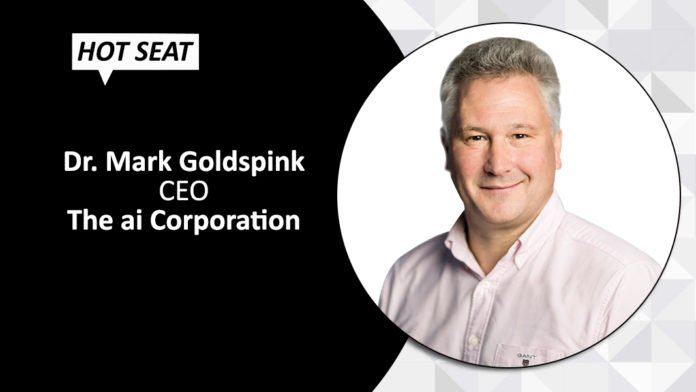
“The automation revolution isn’t coming; it’s here.”
“Successful organizations with a competitive future will continue to ensure maximum sales conversions and payment acceptance, whilst mitigating any risk exposure, by exploiting best of breed technology as much as possible says,” Dr. Mark Goldspink, CEO of The ai Corporation (ai)
How organizations are leveraging AI to track a fraudulent activity (for example, in the financial industry) and what tools are available to the enterprises right now?
Machine Learning is not new in the world of payment fraud. In fact, one of the pioneers of Machine Learning is Professor Leon Cooper, Director of Brown University’s Centre for Neural Science. The Centre was founded in 1973 to study animal nervous systems and the human brain. However, if you follow his career, Dr. Cooper’s machine learning technology was adapted for spotting fraud on credit cards and is still used today for identifying payment fraud within many financial institutions around the world.
Also Read: Firms Need to be “Secure to the Core” Before Considering Digital Transformation
Machine learning technologies improve when they are presented with more and more data. Since there is a lot of payment data around today, payment fraud prevention has become an excellent use case for AI. To date, machine learning technologies have been used mainly by banks. Still, today more and more merchants are taking advantage of this technology to help automate fraud detection, including many retailers and telecommunications companies.
What are the interesting developments in this space for enterprises?
There is a lot of information on how machine learning is helping to understand human behavior and, more specifically, false/positive detection. However, it is our view that there is not enough focus on how automation could benefit the whole, end to end process, particularly within day to day fraud management business processes.
Until now, the fraud detection industry has focused on detecting fraud reactively; but it has not focussed on proactively evaluating the impact of automation on the whole end to end fraud management process. Clearly, the interdependencies on these two activity streams are significant, so the question remains why fraud prevention suppliers aren’t considering both.
Also Read: Automation Is Booming – Robots Are Taking Over Amid Lock-downs
Fraud is increasing, so at what point do we recognize that the approach of ‘throwing’ budget and increasing the number of analysts in our teams is not working and that we need to consider automating more of the process? Machines don’t steal data, so why are the manual processes/interventions not attracting more attention?
It isn’t a stretch to imagine most of the fraud risk strategy process becoming automated. Instead of the expanding teams of today performing the same manual task continually, those same staff members could be used to spot enhancements in customer insight. This would enable analysts to thoroughly investigate complex fraud patterns, which a machine has not identified, or to assist in other tasks outside of risk management, which provide added business value.
Process automation is continuing to innovate and provide increased efficiency and profit gains in the places it’s implemented. The automation revolution isn’t coming; it’s here.
What are the major concerns?
One major concern is the lack of urgency in adopting new ways of working – there is a need to be more agile and innovative to stop the fraudster’s continuing to win. We need to act fast and innovate, but many organizations are struggling to keep up, and the fraudsters are winning.
The use cases are well defined for the use of machine learning and AI, with big data sets, etc. but machine learning will not fix poor data management processes alone. Machines don’t steal data. People do.
With the number of digital payments being made across the globe increasing dramatically, how can organizations ensure maximum sales conversion and payment acceptance, whilst mitigating any risk exposure?
Strategy alignment for taking digital payments is critical. The more organizations can operate holistically and not get caught out by silos and operational gaps, the better. Put simply; if key stakeholders in both the sales and marketing and risk teams are working to the same set of key performance indicators (KPIs), then mistakes will be mitigated. Many issues arise due to operational gaps, and those gaps will be exploited by the highly sophisticated and technically advanced modern-day fraudster.
Also Read: Artificial Intelligence Infused with Big Data Creating a Tech-driven World
The reality is that technology is accelerating the convergence business activities. Managing that convergence and adapting your organization to ensure it remains competitive becomes more and more important. Successful organizations with a competitive future will continue to ensure maximum sales conversions and payment acceptance, whilst mitigating any risk exposure, by exploiting best of breed technology as much as possible.
After graduating from London University with a Ph.D. In Chemistry, Mark started working for a multinational oil company Texaco for 12 years mainly involved in forecourt retailing. In 2000 Mark moved to an Internet Billing company and in 2005 became Managing Director for Retail Decision’s Global Payments and Fraud Division. In 2010, he moved to Logica (bought by CGI Inc. 2012) and was Vice President responsible for managing Shell’s outsourced payment contracts worth over $0.5bn. He joined ai in 2013 to work with Ashley Head on developing and expanding a whole series of inter-related payment businesses globally.
For more such updates follow us on Google News ITsecuritywire News. Please subscribe to our Newsletter for more updates.






